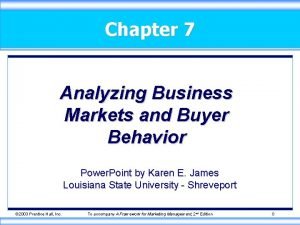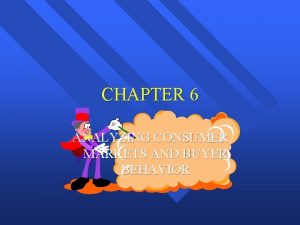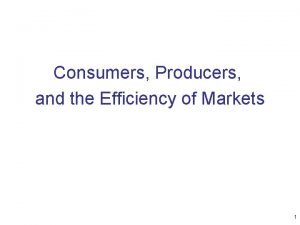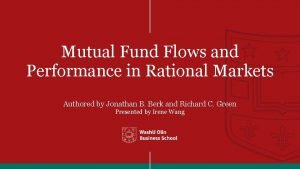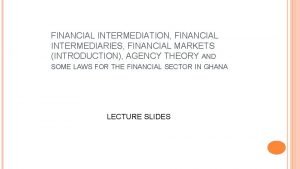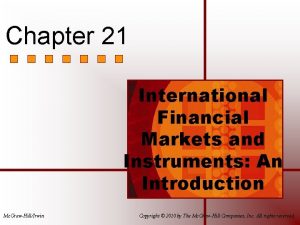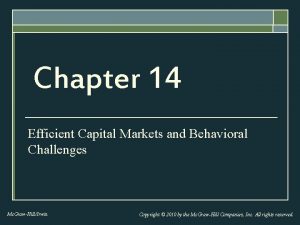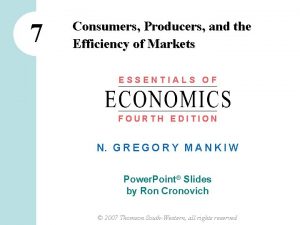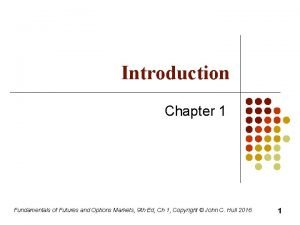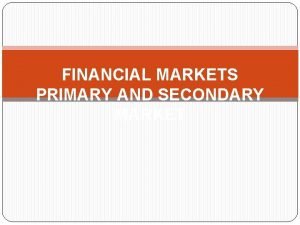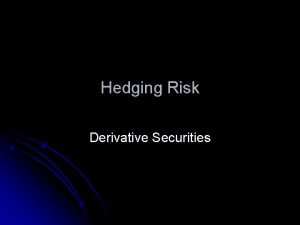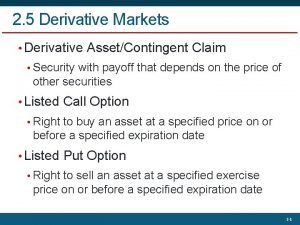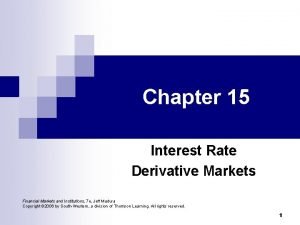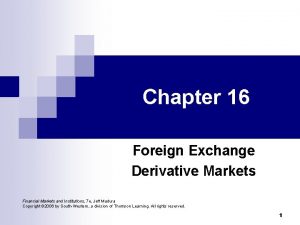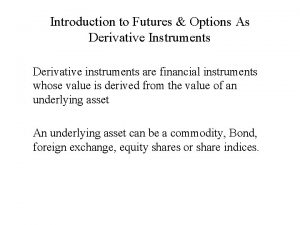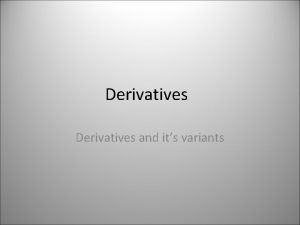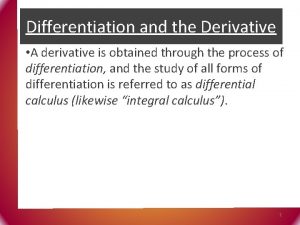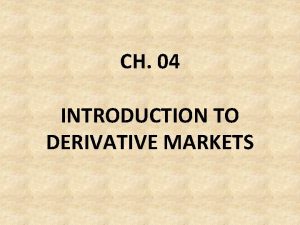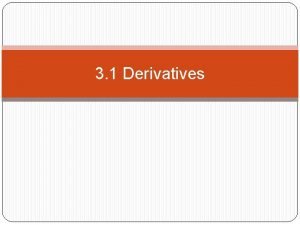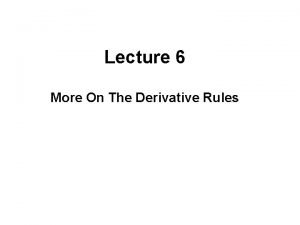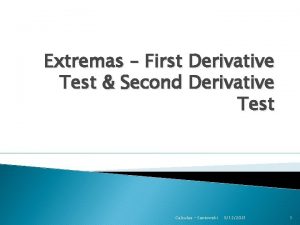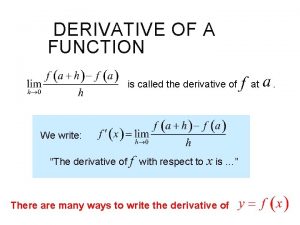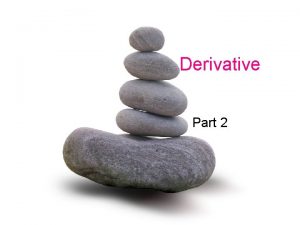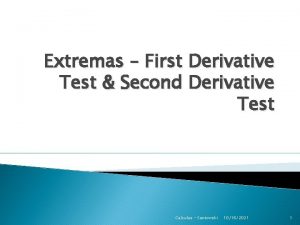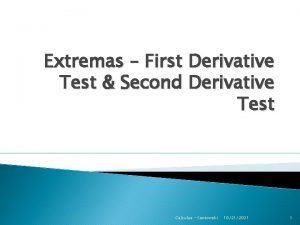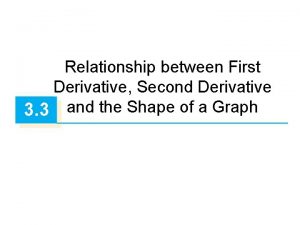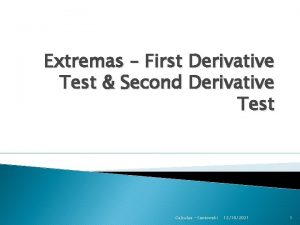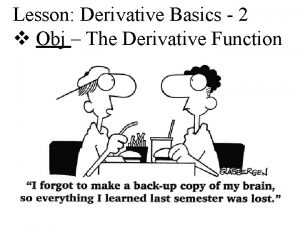Chapter 20 An Introduction to Derivative Markets and





































- Slides: 37

Chapter 20: An Introduction to Derivative Markets and Securities © 2012 Cengage Learning. All Rights Reserved. May not scanned, copied or duplicated, or posted to a publicly accessible website, in whole or in part.

An Overview of Derivatives • Value is depends directly on, or is derived from, the value of another security or commodity, called the underlying asset • Forward contracts are agreements between two parties - the buyer agrees to purchase an asset, the seller agrees to sell the asset, at a specific date at a price agreed upon now • Futures contracts are similar, but are standardized and traded on an organized exchange 20 -2 © 2012 Cengage Learning. All Rights Reserved. May not scanned, copied or duplicated, or posted to a publicly accessible website, in whole or in part.

An Overview of Derivatives • Options offer the buyer the right, but not the obligation, to buy or sell and underlying asset at a fixed price up to or on a specific date • Buyer is long in the contract • Seller or “writer” is short the contract • The price at which the transaction would we made is the exercise or strike price • The profit or loss on an option • Basic types of derivative positions (Exhibit 20. 1) 20 -3 © 2012 Cengage Learning. All Rights Reserved. May not scanned, copied or duplicated, or posted to a publicly accessible website, in whole or in part.

Exhibit 20. 1 20 -4 © 2012 Cengage Learning. All Rights Reserved. May not scanned, copied or duplicated, or posted to a publicly accessible website, in whole or in part.

The Language and Structure of Forward and Futures Markets • Forward contract gives its holder both the right and the full obligation to conduct a transaction involving another security or commodity the underlying asset – At a predetermined date (maturity date) – At a predetermined price (contract price) • There must be two parties (counterparties) to a forward transaction – The eventual buyer (or long position) – The eventual seller (or short position) 20 -5 © 2012 Cengage Learning. All Rights Reserved. May not scanned, copied or duplicated, or posted to a publicly accessible website, in whole or in part.

The Language and Structure of Forward and Futures Markets • Forward and Spot Markets – A forward contract is basically a trade agreement – The terms that must be considered in forming a forward contract are the same as those necessary for a bond transaction that settled immediately (i. e. , a spot market transaction) • The settlement date, at time T rather than 0 • The contract price, F 0, T rather than S 0 • No payments until expiration 20 -6 © 2012 Cengage Learning. All Rights Reserved. May not scanned, copied or duplicated, or posted to a publicly accessible website, in whole or in part.

The Language and Structure of Forward and Futures Markets • Forward and Futures Markets – Forward contracts are negotiated in the over-thecounter market, involve credit (or default) risk, and is quite often illiquid – Futures contracts try to solve these problems with • Standardized terms • Central market (futures exchange) • More liquidity • Less default risk: Margin requirements • Settlement price: Daily “marking to market” 20 -7 © 2012 Cengage Learning. All Rights Reserved. May not scanned, copied or duplicated, or posted to a publicly accessible website, in whole or in part.

Interpreting Futures Price Quotations • Exhibit 20. 3 shows spot and futures prices for contracts on the Standard & Poor’s 500 index as of January 4, 2011 – Expiration date – Contract size • Exhibit 20. 4 summarizes the payoff and net profit for from a long position’s point of view, assuming a hypothetical set of S&P index levels on the March expiration date – F 0, T = 1, 265. 30 – Zero-sum game 20 -8 © 2012 Cengage Learning. All Rights Reserved. May not scanned, copied or duplicated, or posted to a publicly accessible website, in whole or in part.

Exhibit 20. 3 20 -9 © 2012 Cengage Learning. All Rights Reserved. May not scanned, copied or duplicated, or posted to a publicly accessible website, in whole or in part.

Exhibit 20. 4 20 -10 © 2012 Cengage Learning. All Rights Reserved. May not scanned, copied or duplicated, or posted to a publicly accessible website, in whole or in part.

The Language and Structure of Option Markets • An option contract gives the holder the rightbut not the obligation to buy or to sell an underlying security or commodity at a predetermined future date and at a predetermined price – – Option to buy is a call option Option to sell is a put option Buyer has the long position in the contract Seller (writer) has the short position in the contract – Buyer and seller are counterparties in the transaction 20 -11 © 2012 Cengage Learning. All Rights Reserved. May not scanned, copied or duplicated, or posted to a publicly accessible website, in whole or in part.

The Language and Structure of Option Markets • Option Contract Terms – The exercise price (X) is the price the call buyer will pay to-or the put buyer will receive from-the option seller if the option is exercised – The option premium (C 0, T) is the price that the option buyer must pay to the seller at Date 0 to acquire the option contract – European options can only be exercised only at maturity (Date T) – American options can be exercised any time before and at the expiration date 20 -12 © 2012 Cengage Learning. All Rights Reserved. May not scanned, copied or duplicated, or posted to a publicly accessible website, in whole or in part.

The Language and Structure of Option Markets • Option Valuation Basics – Intrinsic value represents the value that the buyer could extract from the option if he or she exercise the option immediately • In the money: An option with positive intrinsic value • Out of the money: The intrinsic value is zero • At the money: When the stock price is equal to exercise price, S 0 = X – The time premium component is simply the difference between the whole option premium and the intrinsic component 20 -13 © 2012 Cengage Learning. All Rights Reserved. May not scanned, copied or duplicated, or posted to a publicly accessible website, in whole or in part.

Interpreting Option Price Quotations • Option Trading Markets-options trade both in over-the-counter markets and on exchanges • Exhibit 20. 6 shows data for a variety of call and put options on the S&P 500 index as of January 4, 2011 – Expiration date – Bid and ask prices – Contract size 20 -14 © 2012 Cengage Learning. All Rights Reserved. May not scanned, copied or duplicated, or posted to a publicly accessible website, in whole or in part.

Exhibit 20. 6 20 -15 © 2012 Cengage Learning. All Rights Reserved. May not scanned, copied or duplicated, or posted to a publicly accessible website, in whole or in part.

Investing With Derivative Securities • Key Difference between Forward and Option – Call option • Requires up front payment • Allows but does not require future settlement payment – Forward contract • Does not require front-end payment • Requires future settlement payment 20 -16 © 2012 Cengage Learning. All Rights Reserved. May not scanned, copied or duplicated, or posted to a publicly accessible website, in whole or in part.

Investing With Derivative Securities • Basic Payoff and Profit Diagrams for Forward Contracts – The payoffs to both long and short positions in the forward contract are symmetric, or two-sided, around the contract price – The payoffs to the short and long positions are mirror images of each other; in market jargon, forward contracts are zero-sum games – See Exhibit 20. 10 20 -17 © 2012 Cengage Learning. All Rights Reserved. May not scanned, copied or duplicated, or posted to a publicly accessible website, in whole or in part.

Exhibit 20. 10 20 -18 © 2012 Cengage Learning. All Rights Reserved. May not scanned, copied or duplicated, or posted to a publicly accessible website, in whole or in part.

Investing With Derivative Securities • Basic Payoff and Profit Diagrams for Option Contracts – The investor receives expiration date payoffs that are asymmetric, or one-sided. For instance, a call option buyer has unlimited upside potential with limited downside risk – The difference between payoff and profit is the option premium (cost), a sunk cost – The payoffs and profits for option buyers and sellers (writers) are mirror images around horizontal line, a result of zero-sum games 20 -19 © 2012 Cengage Learning. All Rights Reserved. May not scanned, copied or duplicated, or posted to a publicly accessible website, in whole or in part.

Profits to Buyer of Call Option 3, 000 Profit from Strategy 2, 500 2, 000 Exercise Price = $70 Option Price = $6. 125 1, 500 1, 000 500 0 Stock Price at Expiration (500) (1, 000) 40 50 60 70 80 90 100 20 -20 © 2012 Cengage Learning. All Rights Reserved. May not scanned, copied or duplicated, or posted to a publicly accessible website, in whole or in part.

Profits to Seller of Call Option 1, 000 Profit from Strategy Exercise Price = $70 500 Option Price = $6. 125 0 (500) (1, 000) (1, 500) (2, 000) (2, 500) (3, 000) 40 Stock Price at Expiration 50 60 70 80 90 100 20 -21 © 2012 Cengage Learning. All Rights Reserved. May not scanned, copied or duplicated, or posted to a publicly accessible website, in whole or in part.

Profits to Buyer of Put Option 3, 000 Profit from Strategy 2, 500 2, 000 Exercise Price = $70 1, 500 Option Price = $2. 25 1, 000 500 0 Stock Price at Expiration (500) (1, 000) 40 50 60 70 80 90 100 20 -22 © 2012 Cengage Learning. All Rights Reserved. May not scanned, copied or duplicated, or posted to a publicly accessible website, in whole or in part.

Profits to Seller of Put Option 1, 000 Profit from Strategy 500 0 (500) Exercise Price = $70 (1, 000) Option Price = $2. 25 (1, 500) (2, 000) Stock Price at Expiration (2, 500) (3, 000) 40 50 60 70 80 90 100 20 -23 © 2012 Cengage Learning. All Rights Reserved. May not scanned, copied or duplicated, or posted to a publicly accessible website, in whole or in part.

Investing With Derivative Securities • Options Pricing Relationships – A positive sign shows a positive impact of the factor on option price – A negative sign shows a negative impact of the factor on option price Factor Call Option Stock price Exercise price Time to expiration Interest rate Volatility of the stock price + + Put Option + + + 20 -24 © 2012 Cengage Learning. All Rights Reserved. May not scanned, copied or duplicated, or posted to a publicly accessible website, in whole or in part.

The Relationship Between Forward and Option Contracts • Put-Call-Spot Parity – Suppose that at Date 0, an investor forms the following portfolio involving three securities related to Company WYZ: – Buy a WYZ common stock at price of S 0 – Purchase a put option for P 0, T to deliver WYZ stock at an exercise price of X on expiration date, T – Sell a call option for C 0, T to purchase WYZ stock at an exercise price of X on expiration date, T – See Exhibit 20. 16 20 -25 © 2012 Cengage Learning. All Rights Reserved. May not scanned, copied or duplicated, or posted to a publicly accessible website, in whole or in part.

Exhibit 20. 16 20 -26 © 2012 Cengage Learning. All Rights Reserved. May not scanned, copied or duplicated, or posted to a publicly accessible website, in whole or in part.

The Relationship Between Forward and Option Contracts • The Implication of Put-Call-Spot Parity – The net investment required to acquire this portfolio is (S 0 + P 0, T – C 0, T) – The net positive at expiration date no matter at what level the stock price is would be the same, X – The result is a risk-free investment S 0 + P 0, T - C 0 , T X = (1 + RFR)T – Since the risk-free rate equals the T-bill rate: (long stock)+(long put)+(short call)=(long T-bill) 20 -27 © 2012 Cengage Learning. All Rights Reserved. May not scanned, copied or duplicated, or posted to a publicly accessible website, in whole or in part.

Creating Synthetic Securities Using Put-Call Parity • Risk-free portfolio could be created using three risky securities: – stock, – a put option, – and a call option • With Treasury-bill as the fourth security, any one of the four may be replaced with combinations of the other three 20 -28 © 2012 Cengage Learning. All Rights Reserved. May not scanned, copied or duplicated, or posted to a publicly accessible website, in whole or in part.

Adjusting Put-Call Spot Parity For Dividends • The owners of derivative instruments do not participate directly in payment of dividends to holders of the underlying stock • If the dividend amounts and payment dates are known when puts and calls are written those are adjusted into the option prices (long stock) + (long put) + (short call) = (long T-bill) + (long present value of dividends) 20 -29 © 2012 Cengage Learning. All Rights Reserved. May not scanned, copied or duplicated, or posted to a publicly accessible website, in whole or in part.

Put-Call-Forward Parity • Instead of buying stock, take a long position in a forward contract to buy stock • Supplement this transaction by purchasing a put option and selling a call option, each with the same exercise price and expiration date • This reduces the net initial investment vs. buying the stock in the spot market • The difference between put and call prices must equal the discounted difference between the common exercise price and the contract price of the forward agreement 20 -30 © 2012 Cengage Learning. All Rights Reserved. May not scanned, copied or duplicated, or posted to a publicly accessible website, in whole or in part.

An Introduction To The Use Of Derivatives In Portfolio Management • Restructuring Asset Portfolios With Forward Contracts – Switching funds between current equity holding and other portfolios mimicking different asset classes – Tactical asset allocation to time general market movements instead of company-specific trends – Hedge position with payoffs that are negatively correlated with existing exposure – Converts beta of stock to zero, making a synthetic t-bill, affecting portfolio beta 20 -31 © 2012 Cengage Learning. All Rights Reserved. May not scanned, copied or duplicated, or posted to a publicly accessible website, in whole or in part.

An Introduction To The Use Of Derivatives In Portfolio Management • Protecting Portfolio Value With Put Options – The purpose is to have a derivative contract that allows stock sales when prices fall but keep the stock when prices rise – The purchase of a put option to hedge the downside risk of an underlying security holding is called a protective put position – Methods • Hold the shares and purchase a put option, or • Sell the shares and buy a T-bill and a call option – Portfolio insurance – See Exhibit 20. 23 20 -32 © 2012 Cengage Learning. All Rights Reserved. May not scanned, copied or duplicated, or posted to a publicly accessible website, in whole or in part.

Exhibit 20. 23 20 -33 © 2012 Cengage Learning. All Rights Reserved. May not scanned, copied or duplicated, or posted to a publicly accessible website, in whole or in part.

An Introduction To The Use Of Derivatives In Portfolio Management • An Alternative Way to Pay for a Protective Put – Collar Agreement: The simultaneous purchase of an out-of-the-money put and sale of an out-of-themoney call on the same underlying asset and with the same expiration date and market price – There is no initial cost to construct a strategy to protect against potential stock price declines by surrendering the potential future stock gains – See Exhibits 20. 4 and 20. 25 20 -34 © 2012 Cengage Learning. All Rights Reserved. May not scanned, copied or duplicated, or posted to a publicly accessible website, in whole or in part.

Exhibit 20. 24 20 -35 © 2012 Cengage Learning. All Rights Reserved. May not scanned, copied or duplicated, or posted to a publicly accessible website, in whole or in part.

Exhibit 20. 25 20 -36 © 2012 Cengage Learning. All Rights Reserved. May not scanned, copied or duplicated, or posted to a publicly accessible website, in whole or in part.

The Internet Investments Online • • http: //www. cboe. com http: //www. cmegroup. com http: //www. onechicago. com http: //www. euronext. com http: //www. schaeffersresearch. com http: //www. eurexus. com http: //www. ise. com http: //www. site-by-site. com/usa/optfut. htm 20 -37 © 2012 Cengage Learning. All Rights Reserved. May not scanned, copied or duplicated, or posted to a publicly accessible website, in whole or in part.
 Why study financial markets and institutions?
Why study financial markets and institutions? Characteristics of buyer behaviour
Characteristics of buyer behaviour Chapter 9 expanding markets and moving west
Chapter 9 expanding markets and moving west Chapter 6 business markets and business buyer behavior
Chapter 6 business markets and business buyer behavior Chapter 5 consumer markets and buyer behavior
Chapter 5 consumer markets and buyer behavior Chapter 5 consumer markets and buyer behavior
Chapter 5 consumer markets and buyer behavior Chapter 9 expanding markets and moving west
Chapter 9 expanding markets and moving west Chapter 9 expanding markets and moving west
Chapter 9 expanding markets and moving west Chapter 7 consumers producers and the efficiency of markets
Chapter 7 consumers producers and the efficiency of markets Cultural dynamics in assessing global markets
Cultural dynamics in assessing global markets Business markets and business buyer behavior ppt
Business markets and business buyer behavior ppt Chapter 18 the markets for the factors of production
Chapter 18 the markets for the factors of production Analyzing consumer markets
Analyzing consumer markets Firms in competitive markets chapter 14 ppt
Firms in competitive markets chapter 14 ppt Financial intermediaries ppt
Financial intermediaries ppt Consumers, producers, and the efficiency of markets
Consumers, producers, and the efficiency of markets Historic tax credits 101
Historic tax credits 101 Business buyer behaviour
Business buyer behaviour Product market boundary structure
Product market boundary structure Financial markets and institutions ppt
Financial markets and institutions ppt Urban economics and real estate markets
Urban economics and real estate markets Dartmouth sociology courses
Dartmouth sociology courses Mutual fund flows and performance in rational markets
Mutual fund flows and performance in rational markets Types of financial intermediaries
Types of financial intermediaries Differentiate consumer behavior and organizational buyer
Differentiate consumer behavior and organizational buyer Target markets and channel design strategy
Target markets and channel design strategy International financial markets and instruments
International financial markets and instruments Efficient capital markets and behavioral challenges
Efficient capital markets and behavioral challenges Consumers producers and the efficiency of markets
Consumers producers and the efficiency of markets Vertical and horizontal markets
Vertical and horizontal markets Capital markets and financial intermediation
Capital markets and financial intermediation Forward vs option
Forward vs option Primary vs secondary financial markets
Primary vs secondary financial markets Financial markets and the allocation of capital
Financial markets and the allocation of capital E-commerce digital markets digital goods
E-commerce digital markets digital goods Difference between supply and quantity supplied
Difference between supply and quantity supplied Foreign exchange and international financial markets
Foreign exchange and international financial markets Equity markets and stock valuation
Equity markets and stock valuation










